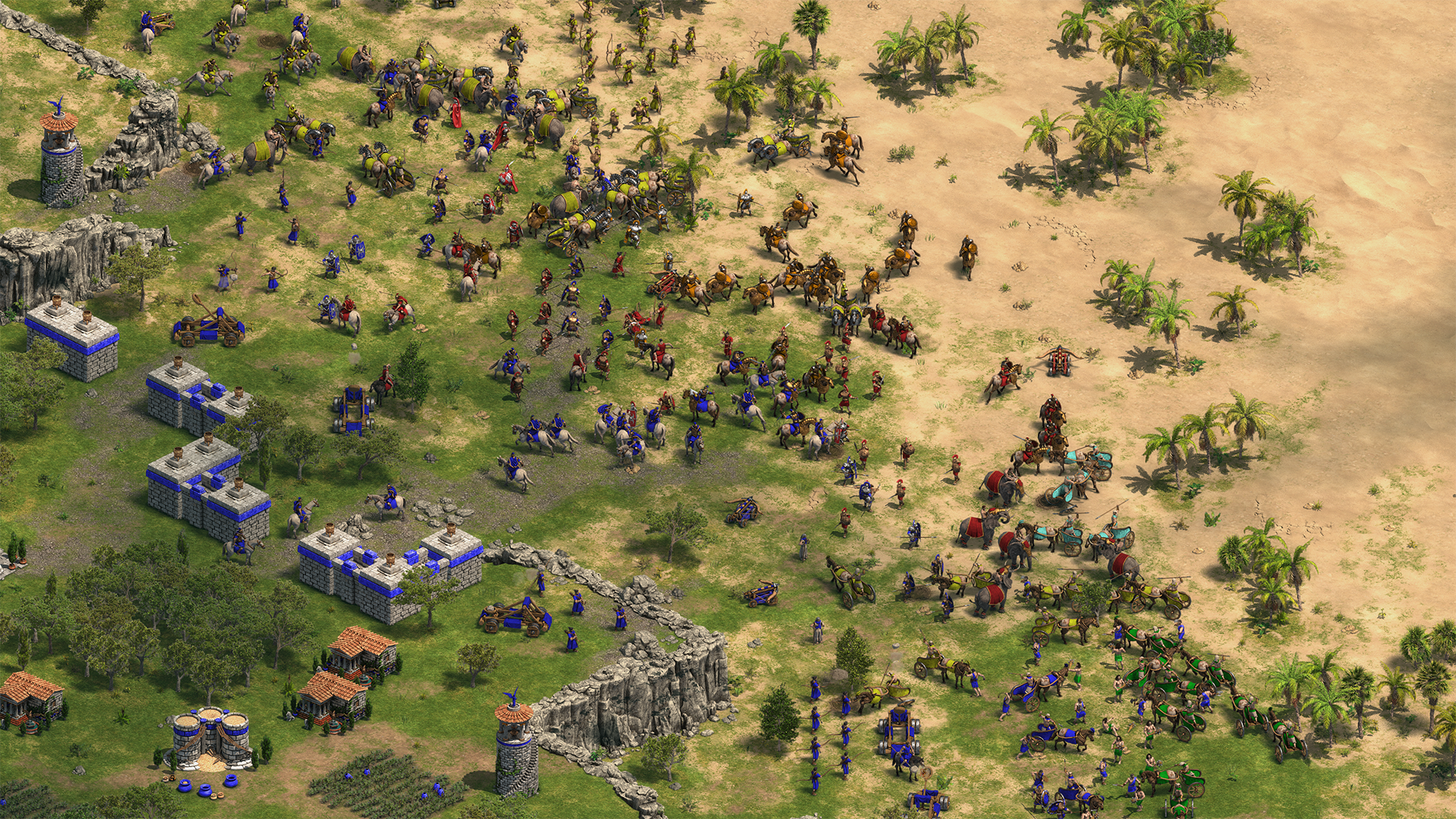Age of Empires Definitive Edition Hands-on: Back and Mostly Better
Age of Empires: Definitive Edition needs a few tweaks, which could make it easier to build a small civilization into a lasting empire.
I don’t want to crush your inner 12-year-old’s nostalgic memories, but the original Age of Empires had a lot of problems.

I’m not saying it wasn’t good; it was. The franchise’s legacy speaks for itself, and you couldn’t have kicked off one of the most beloved RTS franchises of all time with a lackluster game. But having replayed the game just a few years ago, the controls were clunky, the unit balance was off and the campaign was punishingly difficult.
Age of Empires: Definitive Edition (releasing Feb. 20) wants to change all that. This graphically revamped update will bring the game to a modern audience, complete with the smooth gameplay, challenging scenarios and addicting multiplayer which have become hallmarks of the series. The game is currently in closed beta, and I had a chance to go hands-on with it to see how it looks so far.
If Microsoft just wants to give a new generation a look at one of the great-granddaddies of the genre, Definitive Edition gets the job done. But there are still a few more tweaks the developers could make in order to make it just a bit easier to build a small civilization into a lasting empire.
Multiplayer possibilities
First of all — and this is extremely forgivable, but I have to bring it up — the netcode in Age of Empires: Definitive Edition isn’t perfect yet. The closed beta is a multiplayer-only affair, and I found myself matched up with three other random players. Even with a relatively low ping, the game would just about grind to a halt every few minutes, and there was almost always a split second of lag between command and execution.
Interestingly, the action onscreen didn’t seem to affect the game’s performance much. Some pitched battles felt silky smooth, while ordering a handful of units to scout ahead was often a tedious affair.
It’s almost unfair to ding a closed beta for online slowdown, since ironing out these issues is one of the major points of having a closed beta in the first place. Still, this is something that Microsoft will have to fix sooner rather than later, since the game debuts in less than three weeks.
Get instant access to breaking news, the hottest reviews, great deals and helpful tips.
The game would also benefit from a matchmaking service, to match you with people in your region and general skill set. Right now, players have to advertise their own conditions in the match’s name (beginner, intermediate, advanced, teams, United States, Europe, one-on-one, two-versus-two, and so forth). This system works as a stopgap, but it’s vague, at best. One man’s intermediate is another man’s advanced.

Units and queues
The point I’m about to bring up is contentious, but someone has to say it: Age of Empires: Definitive Edition should let players queue technology upgrades. In fact, if it wanted to try something new and ambitious, it should even let players alternate technology upgrades with new units.
For those who haven’t dabbled much in Age of Empires before, researching new technologies is paramount. If your RTS point of reference is StarCraft or Warcraft, you’re probably familiar with a few mid- or late-game upgrades that can make your units more durable when you’ve got nothing better to spend resources on. Age of Empires, however, offers a ton of upgrades right from the beginning, and you’re not going to be able to afford them all before the end of an average match.
What’s always set Age of Empires apart from competing RTS series is that it strikes a relatively equal balance between economics and warfare. You’re not collecting resources and upgrading villagers just to field a bigger army; you can win the game by exploring ruins, collecting artifacts or building a Wonder. You’ll still need a powerful army to defend yourself, but military conquest has never been your only option.
As such, you’ll have access to lots of technology upgrades from the beginning, whether you want leather armor for your infantry, or more food from your farms or moving your civilization up to a whole new Age, complete with new buildings and units. These upgrades are expensive and take time to research, making their value inherently uncertain, especially in the game’s early stages. Every resource you spend on an upgrade could also get you soldiers or villagers.

The bottom line is: There’s a lot of stuff to research, especially at buildings like the Storage Pit and the Market, which offer multiple upgrades from the get-go. But when the game gets into its chaotic middle stages (you’ll be scouting, and gathering resources, and researching technologies, and building an army, and starting to fend off enemy advances, and, and, and), micromanaging research on top of everything else is simply one extra, unnecessary step.
Age of Mythology and Age of Empires III let players queue technology upgrades, provided they had the resources. In other words: You could choose to research both gold-mining and stone-mining upgrades at your market, and the latter would begin as soon as the former was finished.
Top-tier players may argue that if you have that many resources just lying around mid-game, you’re not optimizing your gameplay anyway. But Age of Empires has always appealed to fans for its casual multiplayer matches and single-player scenarios as well. It’s easy to see how this feature could be useful, especially for players who are taking it easy in Random Map games, or trying to tackle the tougher campaign missions.
Letting players queue units in addition to technologies would be even more useful, since some of the most important tech upgrades happen at the Barracks (military units) and Town Center (villagers). This is something that most games don’t allow, but that’s arguably all the more reason for Age of Empires to be a pioneer once again.
Fallow farms
One could argue (not without merit, in this writer’s opinion) that farms in Age of Empires III and Age of Mythology made things a little too simple, with their relatively low costs and infinite food supplies. Farms in Age of Empires: Definitive Edition provide a limited amount of food, and need to be rebuilt constantly. This is fine, but as with queuing technologies, there’s a way to make things simpler.
Age of Empires II: The Conquerors expansion introduced a simple, but revolutionary concept for farms: the auto-queue. By paying for farms up-front, villagers would automatically reseed the land once it went fallow. Like upgrade technologies, farms are a mid-game innovation, and by time they start running out of food, you are going to have more important things to worry about than right-clicking on farms a bunch of times. (Although kudos to the Definitive Edition for allowing farms to be rebuilt, rather than having to build new ones from scratch, as in the original game.)
Basically, my criticisms of the Definitive Edition boil down to busywork. Yes, micromanaging your base is always going to be an important part of the RTS experience, but games like StarCraft II and Age of Empires III have demonstrated how streamlining base-building can help players focus on long-term strategies instead. Ideally, Age of Empires: Definitive Edition should bring players back to the spirit of the 1997 classic, but find a way to leverage some of the innovations the genre has made since then.
Another important thing to note is that, for the most part, Age of Empires: Definitive Edition looks really solid so far. The intricate balance between the races is still there, the graphics look better than ever before and the orchestral soundtrack gives the game’s memorable tunes the treatment they always deserved. If you can find players around your skill level, you’ll enjoy tight, heated matches — and, best of all, the game’s interface won’t be fighting you every step of the way, as it did 20 years ago.
I don’t know whether Age of Empires: Definitive Edition will be a smash hit, but at the very least, I expect it will be a pleasant throwback while the world waits with bated breath for Age of Empires IV. A few small changes could help it go from a remastered curiosity to a mainstay of competitive play.

Marshall Honorof was a senior editor for Tom's Guide, overseeing the site's coverage of gaming hardware and software. He comes from a science writing background, having studied paleomammalogy, biological anthropology, and the history of science and technology. After hours, you can find him practicing taekwondo or doing deep dives on classic sci-fi.
